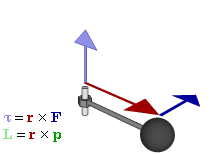Newtonian Mechanics 03
— 1. One Particle Conservation Theorems —
— 1.1. Linear considerations —
— 1.2. Rotational considerations —
| Definition 1 Given a reference point one can define the angular momentum of a particle relative to that point.
$ \displaystyle \vec{L}=\vec{r}\times\vec{p} \ \ \ \ \ (1)$
|
The angular momentum is a measure of the amount a rotation that a particle has relative to a given point. For example if a particle moves in a straight line relative to point its angular momentum is $ {\vec{L}=\vec{r}\times\vec{p}=0}$ since $ {\vec{r}}$ is parallel to $ {\vec{p}}$ and the vector product of two parallel vectors is $ {0}$ by definition (Do you see why? If not go to this post). see the definition of vector product and prove the previous statement.
Just like we had forces in rectilinear motion to account for the variations of momentum one has the torque in curvilinear motion to account for the variation of angular momentum-
| Definition 2 Given a reference point one can define the torque of a particle relative to that point.
$ \displaystyle \vec{\tau}=\vec{r}\times\vec{F} \ \ \ \ \ (2)$
|
Given the definitions of angular momentum it follows that
$ \displaystyle \frac{d}{dt}\left(\vec{r}\times\vec{p}\right)= \frac{d\vec{r}}{dt}\times\vec{p}+\vec{r}\times\frac{d\vec{p}}{dt} $
Hence $ {\vec{\tau}=\vec{r}\times \dfrac{d\vec{p}}{dt}=\dfrac{d\vec{L}}{dt}}$.
Thus if $ {\vec{\tau}=0}$, $ {\dfrac{d\vec{L}}{dt}=0}$ and $ {\vec{L}}$ is constant in time.

— 1.3. Energetic considerations —
Let's consider a particle moves under the action of a force and evolves from mechanical state $ {1}$ to mechanical state $ {2}$.
It is
$ {\begin{aligned} \vec{F}\cdot d\vec{r} &= m\frac{d\vec{v}}{dt}\cdot\frac{d\vec{r}}{dt}dt \\ &= m\frac{d\vec{v}}{dt}\cdot\vec{v}dt \\ &= \frac{m}{2}\frac{d}{dt}(\vec{v}\cdot\vec{v})dt \\ &= \frac{m}{2}\frac{d}{dt}(v^2)dt \\ &= d\left(\frac{1}{2}mv^2\right) \end{aligned}}$
Hence, the integrand function for $ {W_{12}}$ is a total differential (note that we assumed that $ {\vec{F}}$ doesn't depend explicitly on time nor on the velocity). Hence
$ \displaystyle W_{12}=\frac{1}{2}m(v_2^2-v_1^2)=K_2-K_1 $
It follows $ {\begin{aligned} \int_1^2 \vec{F}\cdot d\vec{r} &= -\int_1^2 \nabla U\cdot d\vec{r} \\ &= \int_1^2 \sum_i \frac{\partial U}{\partial x_i}dx_i \\ &= \int_1^2 dU \\ &= U_1-U_2 \end{aligned}}$ Let us define
| Definition 4 The mechanical, $ {E}$, energy of a mechanic system is the sum of the kinetic energy and the potential energy
$ \displaystyle E=K+U \ \ \ \ \ (4)$
|
Now
$ {\displaystyle E = T+U \Rightarrow \frac{dE}{dt} = \frac{dT}{dt} + \frac{dU}{dt}}$
and
$ {\displaystyle \vec{F}\cdot d \vec{r}=d\left(1/2mv^2\right)=dT\Rightarrow \frac{dT}{dt}=\vec{F}\cdot \frac{d \vec{r}}{dt} }$
For $ {dU/dt}$ it is
$ {\begin{aligned} \frac{dU}{dt} &= \sum_i\frac{\partial U}{\partial x_i}\frac{\partial x_i}{\partial t}+ \frac{\partial U}{\partial t} \\ &= \nabla U \cdot \frac{d \vec{r}}{dt}+ \frac{\partial U}{\partial t} \end{aligned}}$
Finally
$ {\begin{aligned} \frac{dE}{dt} &= \vec{F}\cdot \frac{d \vec{r}}{dt}+\nabla U \cdot \frac{d \vec{r}}{dt}+ \frac{\partial U}{\partial t} \\ &= \left( \vec{F}+\nabla U \right)\cdot \frac{d \vec{r}}{dt}+ \frac{\partial U}{\partial t} \\ &= \frac{\partial U}{\partial t} \end{aligned}}$
If $ {U}$ isn't an explicit function of time it follows that $ {dE/dt=0}$ and the mechanical system is said to be conservative.

0 comments:
Post a Comment